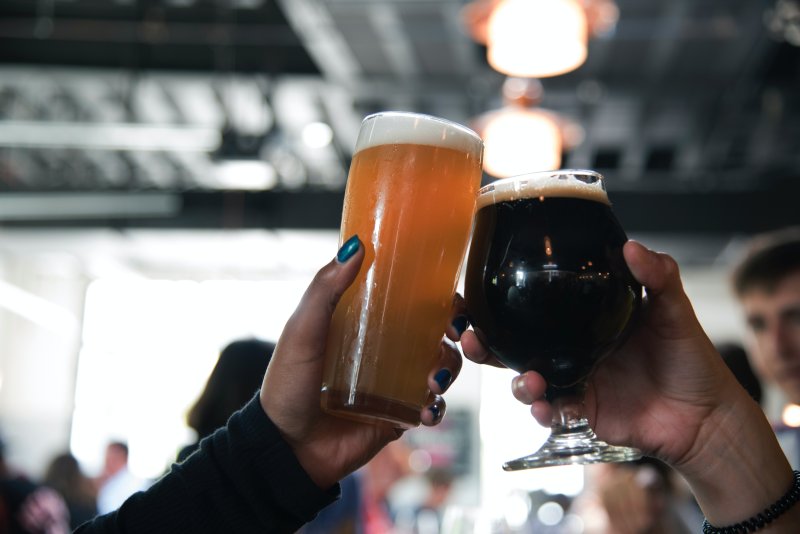Filter Search
Show available only
Categories
Price
Select all
Clear all
$0 - $10
$10 - $50
$50 - $100
$100 - $500
$500 & above
Filter Search
Show available only
Categories
Price
Select all
Clear all
$0 - $10
$10 - $50
$50 - $100
$100 - $500
$500 & above
Product is not availabe in this category, please select other category
ALL ABOUT PORTERS
Brewers first developed the porter style in the eighteenth century in London, England. Some historians believe the name stuck around because it quickly became a favorite among actual porters working in local markets and delivering the drink to pubs. The beer became wildly popular as one of the first styles produced worldwide and was produced in Ireland, North America, Russia, and Sweden by the end of the century. Stouts and porters share many similarities since they both are well-hopped and use brown malt, made with roasted barley, in their production. For many years, the terms and brewing processes got used interchangeably. Many beer aficionados say that the two are commonly seen as the most confused and ill-defined beers. Regardless, their characteristics commonly get described as malty, and full bodied when compared to their stout counterparts.

History
Ralph Harwood gained notoriety for creating porters in 1722. Originally, he called the drink “entire”, which really meant that he blended three types of beer together in thirds. The mixture of beer, ale, and strong beer also earned the name “three threads”, a name which likely came through because of linguistic differences as “three thirds”. Prior to Harwoods invention, pubs produced very young beers that got blended with other beers. Porters became one of the first styles that brewers aged at the brewery that could be drunk immediately. A few prominent breweries started making them in London on large scales and found great financial success for their endeavors. The original porters carried really high alcohol by volume that usually measured around 7%, but increased taxes during the Napoleonic Wars increased the price of malt. Even though it cost more, pale malts produced thirty percent more fermentable material, so brewers often colored their beers to make them look similar to the normal porters. However, a law passed in 1816 made it so that only malt and hops could be used in beer. The solution to this problem came in 1818 when Daniel Wheeler created a device to kiln and roast malts. Brewers could now use pale malts and roast them before adding small amounts of brown malt for flavoring. Before 1800, most porters aged in large vats for six to eight months before being casked and delivered to pubs. As brewers experimented with the process, they realized that the beers didn’t need to be aged nearly as much. They found they could mix one-part highly aged beer (18+ months) with two-parts of a weaker porter and create nearly identical tastes. This method increased production since less beer needed to be aged for long periods of time. By the 1860s, porters' aged taste lost its appeal in many areas. The brews presented as porters got more and more mild. However, brewers continued to brew a stout or two for their patrons. World War I created similar restrictions as the Napoleonic Wars did earlier, and grain shortages in Britain placed restrictions on the strength of beers. In Ireland less strict rules allowed them to produce beers like Guinness at near pre-war strengths. When World War II rolled around, Ireland found similar restrictions and their porters became much weaker as well. The decline in production of porters, which got replaced by single stouts, eventually led to them being discontinued in 1941. Porter saw a resurgence in 1972 when the Anchor Brewing Company started brewing a porter that they released in 1974. By 1978, Penrhos microbrewery and Yorkshire began producing porters as well. Shortly after in 1979, multiple British breweries started crafting their own versions of the drink, which began gaining popularity again when it started winning competitions in the early 2000s.
How Porters Are Made
Even experienced beer connoisseurs regularly struggle with the differences between porters and stouts. The reason for this definitely lies in its history. Since the terms porter and stout commonly referred to the same drink, the processes involved got muddy too. Nowadays, a few distinguishing characteristics separate the two. Porters get brewed with malted barley while stouts commonly use unroasted barley malts. Porters also present a bit lighter and less full bodied than stouts. They were historically a bit weaker in alcohol content too, although this changed over time. Porters gain their characteristics using top-fermentation, which means the fermentation floats on the top of the liquids. Brewers create a mash from pale malt and add small amounts of dark grain for color and boil it for an hour. Afterwards, they sprinkle in water with low-alkaline water and toss in hops. The resulting wort gets boiled again for another hour. Once the second boil completes, the brewers strain out the wort and then add yeast to let the mixture ferment at cool temperatures of about 64°F. After a few hours, they raise the temperature to 68°F and let the mixture remain at that temperature for the remainder of the fermentation. After two to three weeks, the beer can be packaged, carbonated, and sent out for customers to enjoy.
Types of
- Brown Porter - Brown porters usually lack the burnt/black malt characteristics common in porters. They carry a low to mild malty sweetness backed by caramel or chocolate flavors, a medium bitter quality from the hops, and taste softer and more sugary than robust porters.
- Robust Porter - Like the name suggests, robust porters carry a more full taste of roasted malt that tastes somewhat like cocoa without roasted barley flavors. The hops used typically present as more bitter than brown porters, which gets balanced out by their malty, caramel sweetness.
- Baltic Porter - Baltic porters present complex multi layered malt flavors that taste close to burnt, backed by tastes of dark fruit. On the initial drink they’re smooth and sweet, finishing with hints of roast coffee or liquorice on the finish.
WHAT DO PORTERS TASTE LIKE?
Porters carry dark flavors of coffee, chocolate, caramel, dark fruits, and liquorice among others. Since brewers approach them with different flavors in mind, the tastes vary considerably and can even range into peppermint and pumpkin flavors depending on the ingredients used to make them. Generally, they carry a bit of bitterness from their hops, which balances out nicely with the sweetness of the other flavors. Some varieties can taste much more hoppy than others. Like their taste, the consistency of porters vary from light bodied to full and heavy bodied. Check out product descriptions to find the consistency and taste that’s right for you!

How to Drink Porters
Beer aficionados love the different flavors porters offer and recommend them in glasses. This helps them form a good head that contains some of the flavors while also letting them air out and release some carbonation. Porters pair wonderfully with many different dinner foods and barbeques, and with the variety of styles and flavors represented across the category, hosts and beer lovers can find a style right for pretty much any occasion.
What Makes Porters Popular
Porters offer a variety of different flavors that beer drinkers chase including chocolate, honey, vanilla, pumpkin, and plum. They present as very dark beers and commonly get described as malty and full bodied beers. Porter beers initially gained popularity because they were the first beers brewed with the intention of tasting a specific way instead of just using available ingredients. Despite dying out for a short period, they resurged and many different breweries offer their own takes on porters. Their wonderfully full taste compliments meals, making them ideal for barbeques or dinner parties.
Please select your delivery location for us to get the order deliver faster.
Home
Cart
Profile
Location
